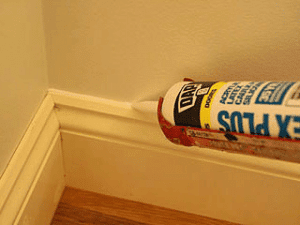 Baseboards are a classy addition to just about any room, providing definition to the walls, and extra detail and depth to the whole appearance. It also provides a useful coverup for the meeting place of the walls and floor, which can be difficult to finish nicely. Fortunately, installing baseboards is one of the easiest do-it-yourself projects that a homeowner could undertake. One question they often ask, however, is “do I need to caulk my baseboards?”
Baseboards are a classy addition to just about any room, providing definition to the walls, and extra detail and depth to the whole appearance. It also provides a useful coverup for the meeting place of the walls and floor, which can be difficult to finish nicely. Fortunately, installing baseboards is one of the easiest do-it-yourself projects that a homeowner could undertake. One question they often ask, however, is “do I need to caulk my baseboards?”
Should I Caulk My Baseboards?
In most cases, residential painting contractors recommend caulking baseboards. This creates a seamless, smooth transition from the baseboard to the wall. If this is not caulked, it often leaves a gap that widens and changes where the wall is uneven. Also, caulked baseboards are easier to dust or clean, since the caulk fills in a notorious dust-collecting corner.
What Color Caulk Should I Use for my Baseboards?
The typical color for baseboards is white, as this creates a clean, attractive contrast and frame to the wall. If your baseboards are white, use white caulk as well. Make sure to use an indoor, paintable caulk with long-term elasticity. If your baseboards are not white, use a caulk that is the same color as the baseboards, not the walls. If you cannot find any matching caulk, then use any color of paintable caulk, and then paint your baseboards and caulk together after applying the caulk.
How Do I Caulk Baseboards?
First, use a utility knife to cut open the tip of your tube at an angle, leaving a hole 1/8 to 1/4 inch in diameter. Have a clean, wet rag at hand for wiping up excess caulk. Begin at one end and apply a thin bead of caulk in the crack. Cover a stretch of approximately 4 feet. Next, get your finger damp, and use it to smooth out the caulk, pressing it into the crack and spreading it neatly against the wall and the baseboard. Clean your finger on the rag, and wipe up any caulk that went beyond where you wanted it. Repeat this process until you get to the next corner.
If there is a space where the wall and baseboard do not meet (which is typically because of an irregularity in the drywall), fill the gap with caulk, and then smooth it over. If the gap is very large, you can save some caulk by putting wadded paper or small wood scraps in the space.
Consider a Painting Contractor
Of course, the easiest way to caulk your baseboards is to contact a painting contractor. Professional painters work with caulk all the time, whether around windows, bathtubs, sinks or baseboards. They can get you the right products, and install them with a high level of professionalism for lasting, attractive results.
You can also learn more about baseboard painting and maintenance through our blog.
If you have any questions you’d like answered here, ask us via twitter or Facebook.